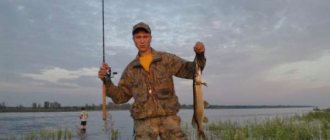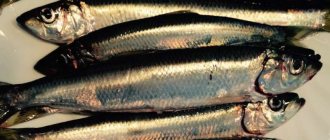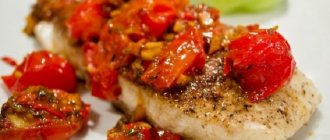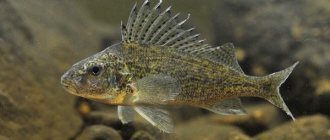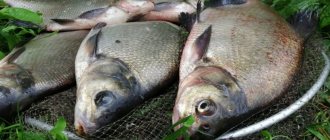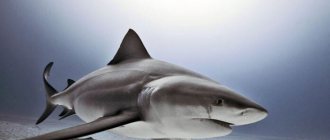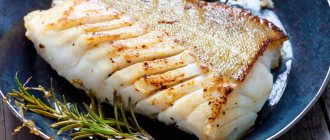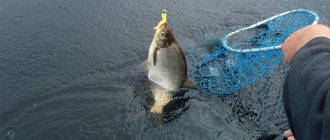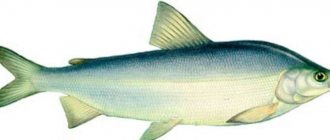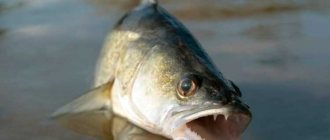In the flounder family (lat. Pleuronectidae) there are dozens of genera and hundreds of species that lead a predatory lifestyle and, with rare exceptions, spend it in salt water. Of particular fishing interest is the halibut fish, which grows to enormous sizes and has tasty and healthy meat that protects the human body from diseases of the central nervous system and cardiovascular disorders. This representative of the flounder is also called the “sea tongue,” although the term refers more to the more accessible European saltfish and freshwater pangasius catfish (pangasius). Successful halibut fishing requires the ability to distinguish between its species, habits and habitat. It is important to take into account the gastronomic preferences of the fish and its feeding style in order to choose the right bait and tackle.
Description of halibut
The family includes 5 similar species, each of which has important commercial significance and is considered a desirable trophy. Over its long life (30-50 years), the fish is able to grow to impressive size and weight.
The largest halibut in the world was caught near the coast of the Norwegian Sea, it weighed 241 kg and reached a length of 2.5 m. Ichthyologists say that this is not the limit and in nature there are individuals over 4.7 m tall and weighing over 360 kg.
Regardless of size and age, all halibut representatives are characterized by common external and physiological features:
- asymmetrical head;
- flat body in the shape of an elongated oval or diamond;
- the upper side, on which both eyes and the mouth section are located shifted to the right;
- light and rough blind (blind) side;
- narrow interorbital space,
- thorn at the anus;
- small caudal fin with a notch;
- the average width of the body is equal to 1/3 of its length.
The ocular (sighted) side is covered with small scales with a high adherence density. The final size, weight and basic color of the fish depend on the taxonomy, bottom color and specific living conditions.
Fishing gear for successful halibut fishing in Norway
Magne, not hiding his curiosity, examines the fishing gear of the guests. The class of reels and spinning rods, from his point of view, was fully consistent with what local fishermen usually use. The swivels and carabiners were especially respected. Judging by the inscriptions on the packages, it guaranteed their stable operation at maximum loads of up to three hundred and sixty kilograms.
Everyone was surprised by Magne's remark that the most popular fishing line diameters for sea fishing in Norway are 0.28 - 0.35 mm. In his opinion, the DAM Sumo braided line with a diameter of 0.55 mm, which the fishermen from Moscow brought with them, has an excessive margin of safety. But the size of the baits, in his opinion, was not quite suitable for fishing conditions on the open sea. Lures weighing one hundred or two hundred grams are too light for halibut fishing. Once you step outside the fjords, the ocean current turns them into fly fishing flies.
The traditional Norwegian version of the bait is a jig; for halibut it goes over half a kilo.
This is what a seven hundred gram bait looks like, which should bring the desired trophy.
Habitats and types of halibut
This representative of the flounder family lives exclusively in the clean and cool water of the Atlantic, the Pacific North, and the marginal seas of the Arctic Ocean. In Russia, halibut fish is represented by all five species existing in nature. This became possible due to the enormous extent of territorial waters along the northern and eastern borders of the country. In addition, halibut-shaped flounders (narrow-toothed, northern) swim off the Kamchatka coast, which are similar to the original both in appearance and in lifestyle, but are significantly inferior in size: they grow to 1.2-1.8 kg with a height of 52-58 cm.
To learn more:
Fish of the flounder family: description of varieties
Halibuts
The genus consists of two species, which determine the maximum possible size of the entire family and are extremely valuable for fishing. 100 g of meat contains up to 1 g of polyunsaturated fatty acids Omega-3, glutamic, aspartic acids and other substances beneficial to the body:
- potassium (528 mg), phosphorus (287 mg), selenium (55.4 μg);
- vitamins D (231 mcg), A (24 mcg), B9 (14 mcg) and PP (12.6 mg);
- ash (1.6 g), proteins (18.6 g), healthy cholesterol (60 mg).
The total calorie content is only 103-142 kcal, which, combined with a low fat content (up to 4.8%), makes the product dietary and easily digestible.
Pacific and Atlantic halibut
The largest species is the Pacific halibut (lat. Hippoglossus stenolepis), which is capable of growing more than 4.5 m in length and gaining a weight of over 3.5 centners. It lives at depths of up to 1.2 km, preferring water with a temperature of +3-8C. The flat body is diamond-shaped and colored brown or greenish-gray with randomly scattered dull or contrasting spots. The wide mouth is equipped with many large sharp teeth, which are unevenly distributed between the lower (1 row) and upper (2 rows) jaws. In Russia, it lives in the waters of the Okhotsk and Bering seas. In catches it is usually represented by young animals weighing 3-6 kg.
Atlantic halibut (lat. Hippoglossus stenolepis) prefers greater depths of up to 2 km and can also reach a length of 4 meters or more. Its dark brown or gray eye side of the body is covered with large rounded scales (cycloid), each of which is surrounded by smaller plates along the perimeter. In the area of the pectoral fin, the lateral line forms a strongly curved arc. In Russia it is found in the White and Barents Seas and in the waters of the Arctic Ocean near Novaya Zemlya.
Arrowtooth halibuts
This genus also consists of two species, which are characterized by different scales. The ctenoid plates on the eye side have posterior edges with a spiny ridge of spines, which significantly increases the level of protection from predators (pollock, pollock, seal). The blind side is equipped with ordinary cycloid scales with rounded edges (75-110 in a row). There are two rows of pointed teeth on the upper and lower jaws.
To learn more:
Fishing for burbot in winter
The Asian arrowtooth halibut (lat. Atheresthes evermanni) is a schooling fish, lives 30-35 years and grows up to one meter with a weight of up to 9 kg. But individuals weighing 1.5-3.0 kg and 40-70 cm long are considered standard. The main color is grayish-brown, which is much lighter on the blind side. The large dorsal fin extends from head to tail. In Russia, it lives in the Seas of Japan, Okhotsk and Bering at depths from 25 to 2000 meters and leads a sedentary lifestyle. In summer it comes out into shallow water, in the cold season it moves into deeper layers.
The American arrow-toothed halibut (lat. Atheresthes stomias) lives no more than 25 years and is not inferior in size to its Asian relative. The maximum weight is recorded at 8.6 kg with a height of 84 cm. But in regular catches, the body length is 40-60 cm and the weight is 1.5-2.5 kg. It has a continuous straight lateral line and a combined scaly covering: the sighted side is ctenoid, the bottom side is cycloid. There are from 95 to 105 scales in a row.
A distinctive feature of this type of halibut is two nostrils with valves on each side, the upper eye extending beyond the edge of the head and a dark brown color. The blind side is lighter, with a purple tint. In Russia it lives in the Bering, Chukchi and Okhotsk seas.
Arrowtooth halibut
Black halibuts
There is only one representative in the genus (lat. Reinhardtius hippoglossoides), which is characterized by fairly large size (up to 130 cm) and weight (over 40 kg). The catches are dominated by individuals 55-65 cm long and weighing 3-4 kg. It has a high limit of resistance to temperature fluctuations in the external environment and feels excellent in cold water down to –1.5 C, which allows it to live at depths of over 2000 m. This species is often called “blue-skinned halibut” for the color of its blind side in black and blue with silvery tint. The eye side has dark gray tones. In Russia, it lives off the coast of Kamchatka, Sakhalin, the Kuril Islands in the Bering and Okhotsk Seas.
To learn more:
Smelt: description of a fish from the smelt family
Halibut feeding habits and habits
All species, without exception, are dangerous predators with numerous sharp teeth and a large, tenacious mouth. They are quite adventurous and can actively search for prey, but more often they hunt from ambush, skillfully camouflaging themselves in folds of the relief and bottom sediments.
The basis of halibut nutrition includes:
- gastropods and cephalopods - squid, octopus, littorina, cuttlefish;
- crustaceans - shrimp, crabs, hermit crabs, euphasids and other crustaceans;
- fish - pollock, herring, cod, gobies, capelin, haddock, slingshot, etc.
The diet can vary significantly depending on the season and the size of the individual. Large halibut eat mainly fish.
Representatives of the flounder family spend their entire lives on a soft bottom (silt, sand, pebbles), choosing for this great depths from 25 to 2000 meters. In summer, they move closer to the shore and to the shallows in search of growing juveniles of other species.
At first glance, some slowness and awkwardness are noticeable in the habits of the halibut. The fish slowly crawls along the bottom and can lie motionless for hours, resting or looking for suitable prey.
It is the swift attack that brilliantly demonstrates the agility of the fish, while it can swim flat or on its side, make sharp turns and dive at enormous speed.
Halibut lifestyle and nutrition
Due to the flat shape of the fish's body, it puts significant pressure on the rod, and lifting it to the surface from a depth of hundreds of meters is not an easy task. The halibut family includes 5 species, which are classified as flounders. All of them are found in the cold seas washing the shores of Russia. The largest representative of the family is the Atlantic halibut, which can weigh more than 300 kilograms. However, truly trophy prey is rarely caught on the hooks; usually the size of the predator that pecks ranges from 10-30 kilograms.
Halibut Spawning
The spawning time of flounders is determined by specific species differences, the conditions of the reservoir and the heating of the water to a temperature of +2-7C. In Russian territorial waters this is the period from October to May. Regardless of where halibut lives, it goes to relatively shallow waters with depths of 50-100 meters to spawn. The process of spawning involves sexually mature individuals aged 7-8 years, which are distinguished by high fertility. One clutch can contain several million eggs with a diameter of 3-4 mm. After spawning, halibuts immediately switch to increased feeding, gradually migrating to greater depths.
The incubation period for the development of larvae can take from 2 to 6 weeks. At first they are in the water column, then they rise closer to the surface, where they are picked up by the current and carried to the shallow coastal waters. It is here that, having sunk to the bottom, they begin to actively feed on benthos and the smallest sea inhabitants.
The most interesting thing is that the fry has a classic symmetrical shape for fish, but soon one side begins to grow rapidly, leading to a flattening of the body and a displacement of the eyes and mouth to the right side.
A little about alchemy
Well, a few words about secondary factors. I have read about the dependence of the bite of various sea fish on the phase of the moon: they say, on a full moon it is passive. I have repeatedly addressed this question to experienced Norwegian, Finnish and German comrades - everyone unanimously assured that this is archaism. The only thing that can be said for sure about the influence of the moon is the level of ebb and flow, which reaches its maximum value (220 cm or more) during periods of the full moon. However, in our modest practice, we have not noticed any stable dependence of the bite on the level of tide or ebb and generally on the phase of the sea.
Halibut were biting both at high and low tides, and with comparable frequency. So today I would argue that there is no better or worse time to fish for halibut. There are only three objective points here: the right place, the right season and (to a lesser extent) the wind, namely its direction and strength. It is believed that in northern and northwestern winds the fish bite is weak. There is something in this, but I would say that this moment is more technical. The fact is that the north-west blows into the fjord from the open sea.
The open spaces there are huge, and the wind has room to roam - sometimes the waves under these winds are serious. The boat begins to drift too quickly, the baits begin to float uncontrollably somewhere in the depths, not reaching the bottom, the “braid” goes into the water almost horizontally. Of course, fishing ends here until the weather improves. When the wind changes, which happens five times a day, the situation changes - and we can fish comfortably again. Halibuts are waiting!
How and where to catch halibut
Commercial catch of flounder fish is carried out using gill nets, trawls, bottom longlines and seines. In order not to harm the population, a non-spawning period is selected from June to October. During the same time frame, you can individually catch halibut in the Barents Sea and other marginal waters of the Arctic Ocean. For fishing, it is best to use a specially equipped boat, which will provide optimal conditions for actively searching for bottom fish.
To learn more:
Smelt - features and varieties, beneficial properties and how to cook
The gear usually chosen is a powerful short spinning rod with a multiplier reel, on which 300-350 meters of strong cord are wound. The bait is rotating spoons (jigs) or jig heads weighing from 100 g with additionally attached edible silicone, a piece of fish or live bait 15-20 cm long (cod, pollock, haddock).
Spinning fishing for halibut must be smooth and unhurried. The bait that has sunk to the bottom should be raised by 50-60 cm, dragged a few meters and lowered again as much as possible. The fisherman must avoid sudden jerks with the rod so as not to spook the fish. A confident and strong bite usually follows when the bait lifts off the bottom. Another effective tackle is a simple donka with live bait or a piece of fish fillet attached to a hook.
Places with moderate currents and depths of 30-100 meters deserve special attention. Here you can effectively implement silent trolling from a drifting boat using a special device for deepening the bait - a downrigger.
Halibut fishing
Catching big halibut is the dream of many fishermen around the world, and this is not surprising. Catching this most powerful predator will be remembered by the fisherman for the rest of his life. Moreover, halibut meat is extremely tasty, which only adds to the joy of catching it.
Although halibut is a flounder-like fish, it has a longer body and its eyes are located on the left side of the head. Different types of halibut (white-skinned, blue-skinned, arrow-toothed) live in the seas that wash the northern and eastern regions of Russia.
Halibut feeds mainly on various crustaceans, fish fry and benthos. Halibut is not afraid of low temperatures, which is why it can be found in the coldest bodies of water on our planet.
If you want to get acquainted with other marine fish species, we recommend articles about the following fish: flounder, cod, pelengas.
This fish spends most of its time at great depths, so heavy tackle and massive baits are used to catch halibut. The average weight of halibut is 20-22 kg, although there are also individuals weighing more than 100 kg. This marine predator is caught from early July to early October.
Where is halibut caught?
Several species of halibut live in the Barents, Bering, Okhotsk and Japan seas.
Halibut is caught at depths from 20 to 300-350 m.
In both the Barents and Bering Seas, it is worth, first of all, to explore the territory of the continental slope, where blue-skinned and white-skinned halibut like to swim.
To the south, halibut is caught near the coast of the Kamchatka Peninsula, Sakhalin and the Kuril Islands.
In the Sea of Japan, halibut are often caught in the shallows along the northern coast.
Halibut fishing gear
Traditional gear for bottom fishing for halibut is a strong short rod and a powerful reel (multiplier), on which 300-350 m of cord is wound, capable of withstanding a load of up to 100 kg. The most common sinker is a lead “icicle”, which practically does not get stuck between stones at the bottom of the sea.
The role of baits is usually assigned to large jig heads, which weigh about 200-500 g. Either silicone baits or fish (for example, cod) are attached to the jig head itself; you can use both live and dead fish.
Playing with bait involves raising the rig by 60-80 cm and then lowering it. The amplitude should be small, and sharp jerks with the rod should be completely eliminated. Halibut is quite cautious, and therefore only bites on smoothly moving baits.
Halibut rigs
Halibut fishing with small fish
The oldest, but still effective way to catch halibut is to use a powerful short rod and a dead fish as bait. This method is especially popular in modern Norway, where in parallel with vibrating tails mounted on strong jig heads, natural baits are also used. Fishing with small dead fish is effective when the halibut rises to feed closer to the surface.
In this case, artificial baits and large jig heads often scare away the predator, while a real fish on a hook attracts not only its appearance, but also its smell.
The equipment used for fishing at relatively shallow depths (15-30 m) is very simple; you only need to have a sinker with a leash on a strong swivel. The length of the leash should be 1.5-2 m, monofilament fishing line with a diameter of 1.1-1.2 mm is used.
Halibut fishing in the Barents Sea
In the Barents Sea, it is blue-skinned halibut that is widespread - a large fish with white meat, which is distinguished by its high taste in almost any cooking method.
Halibut does not form schools, and single specimens are often found in cod habitats. In the Barents Sea, this predator swims mainly in the bottom water layer in areas with a flat sandy bottom. In places with a rocky bottom, halibut are found much less frequently. The following pattern also often applies: the greater the fishing depth, the larger the fish caught. Although in pursuit of trophy specimens you can often end up without a catch at all.
Catching giant halibut (video)
Halibut fishing in Kamchatka (video)
Halibut fishing in Norway (video)
| Spinning rod rigs (Texas, Carolina, dropshot) | Fishing knots and leashes, knot strength | How to disassemble and lubricate the reel |
| Fishing with jerkbaits | Fishing with surface baits (gliders) | Propbait fishing (lure with a propeller) |
| How to choose a popper, what to look for when choosing | Devon fishing (unique spinner with a propeller) | Do-it-yourself spinnerbait (making and fishing) |
fisher-book.ru
Halibut dishes
Flounder fish meat is valued for its taste, nutritional value, lack of bones and an optimal range of nutrients: amino acids, vitamins, minerals, proteins. Regular use of such a product allows you to smooth out problems with anemia, atherosclerosis, metabolism, arrhythmia, etc. Due to the tender and dense structure of the fillet and moderate fat content, halibut is prepared using almost all culinary techniques. It can be boiled, baked, salted, fried, marinated, smoked, steamed, deep-fried, grilled, etc. Granular halibut caviar is very tasty, which, despite its affordable price, is not inferior in gastronomic properties to products of the salmon and sturgeon group.
